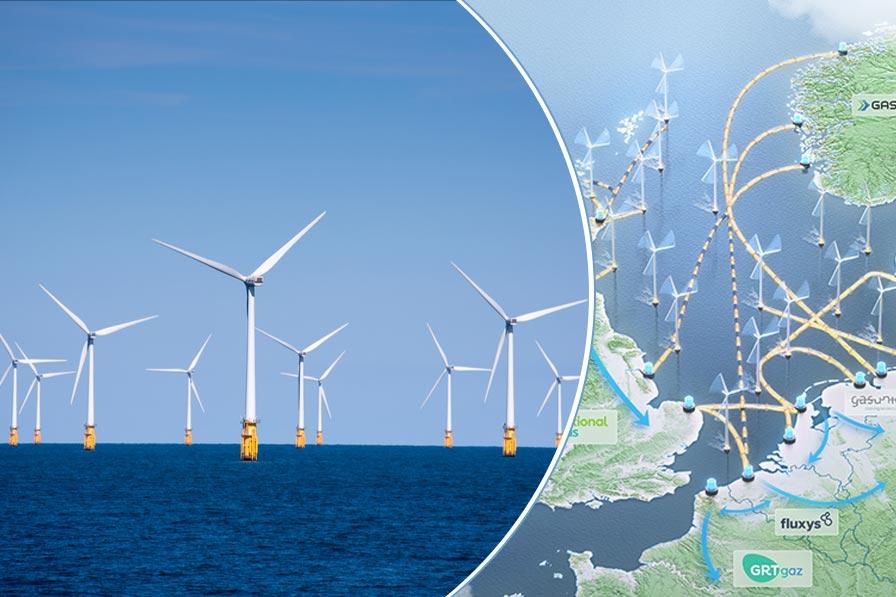Support for the development of renewable energy potential of the North Sea

On the eve of the North Sea Summit in Ostend, Belgium, GRTgaz along with gas transmission system operators (TSOs) from Belgium, Denmark, Ireland, Germany, Netherlands, Norway and the UK have signed a joint declaration to support the development of the North Sea’s renewable energy potential. In this declaration, GRTgaz and its European counterparts commit to contributing to the harmonious development of all the renewable energy resources the North Sea has to offer, by leveraging the contribution of hydrogen infrastructure.
“Thanks to its flexibility, hydrogen is an ideal complement to intermittent renewable energies as a way of achieving the European decarbonisation targets. GRTgaz, in conjunction with neighbouring gas transmission system operators, is working on developing an interconnected hydrogen transmission network linking the main renewable and low-carbon hydrogen sources to consumers and storage facilities, thus ensuring competitiveness and security of supply.”Thierry Trouvé
Chief Executive Officer of GRTgaz
GRTgaz, un acteur engagé pour le développement de l’hydrogène en mer du NordGRTgaz – committed to developing hydrogen in the North Sea
GRTgaz is active on the North Sea coast and is building a cross-border hydrogen transmission network between Valenciennes and Mons, with input from Fluxys (Belgian gas transport operator) and a network in the Dunkirk port area. GRTgaz is planning to extend these hydrogen transmission networks in northern and eastern France, and to create an interconnector between France and Belgium. This set of infrastructure, which will help create a hydrogen corridor in Western Europe, is a candidate for the “PCI” label (awarded in recognition of projects in the common interest).
On the North Atlantic – West Channel façade which borders Brittany and the Pays de la Loire region, the Syndicat des Energies Renouvelables (France's renewable energies union) and France Energie Eolienne (the wind power branch) estimate that wind power production potential could reach 25 GW by 2050. GRTgaz is already working with a number of industrial partners and public bodies on defining a trajectory for transporting these hydrogen reserves by 2030-2040.
North Sea Summit: a commitment from all gas transmission operators to develop renewable energies
The North Sea has the potential to deliver safer, more affordable, and more sustainable energy for Europe. The deployment of renewable energy in the North Sea, including green electricity and green hydrogen produced from offshore wind, together with carbon capture and sequestration, will be key to achieving the target of net-zero greenhouse gas emissions by 2050, in line with France’s national low-carbon strategy, the European green pact and the UK's Net Zero strategy.
In order to achieve the ambitious targets for both offshore wind production and associated green hydrogen production capacity, the North Sea gas transmission system operators – Energinet, GRTgaz, Fluxys, Gascade, Gas Networks Ireland, Gassco, Gasunie, National Gas Transmission and OGE – have signed a joint declaration which they have conveyed to their respective heads of state.
In the declaration, the gas transmission system operators commit to facilitating the harmonious development of the North Sea's full renewable energy potential. Taking into account prospects for offshore wind capacity of each country around the North Sea, some countries will benefit from excess renewable energy production while other countries will not have enough domestic resources. This will drive import-export flows between countries thanks to a renewable offshore energy system – both electricity and hydrogen.
With their experience in operating gas pipelines in and around the North Sea with third-party access services in a regulated environment, ensuring safe gas supply to European customers, gas transmission system operators have been mobilised to deploy hydrogen pipeline infrastructure, possibly by repurposing existing natural gas offshore pipelines and/or installing new onshore pipelines. Depending on the specific features of each country and how the market is structured, this experience may also be used as a basis for deploying CO2 transport infrastructure.
In order to harness the full resource potential of the North Sea, the gas transmission system operators are calling upon all stakeholders – from gas and electricity transmission system operators to future hydrogen network operators and policy makers – to join forces on the following key action points:
- Developing a cost-benefit framework to address cross-border cost allocation and financing issues between countries
- Developing a legal and regulatory framework for the optimal deployment of the necessary hydrogen and CO2 transmission infrastructure
- Developing a market framework to enable the early deployment of the offshore hydrogen value chain
- Speeding up the permit-granting processes and maritime spatial planning (master plan) with the involvement of electricity and gas transmission system operators
